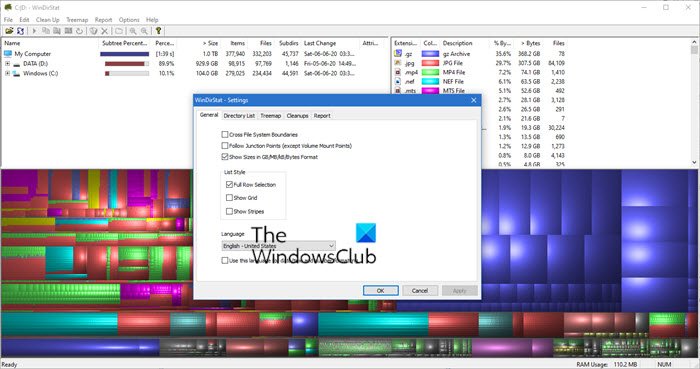Has your Windows computer ever suffered dramatic hard drive space loss for no obvious reason? If yes, chances are the problem is not with your software but few directories. So, what do you do under such circumstances? Of course, scan your computer to find out which files, folders, or directories are eating the most disk space. We have already taken a look at some free Disk Space Analyzer software. The built-in Disk Footprint Tool in Windows also lets you carry out several tasks about Disk Space usage. You can use it to take snapshot summaries, analyze disk usage, anonymize, compare growth over time using disk growth study, and more. Today let’s check out the well-known WinDirStat.

How to analyze Disk Space Usage on Windows
WinDirStat is a disk usage statistics viewer and cleanup tool for Microsoft Windows. The program comes in two variants:
- Ansi – For Windows 9x and ME users.
- Unicode – for all other users
How WinDirStat helps
WinDirStat reads the whole directory tree once and then presents it in three useful views:
- The directory list – It resembles the tree view of Windows Explorer but is sorted by file/subtree size,
- The treemap – It shows the whole contents of the directory tree straight away,
- The extension list – It serves as a legend and shows statistics about the file types.
How to use WinDirStat
Download WinDirStat by clicking on the download link provided at the end of the article and save the file. The file will be saved to your computer
Now, locate the installation file and double-click on the file
Next, click ‘Run’; accept the license and click ‘Next’. Continue clicking the ‘Next’ button of each wizard until the application gets installed completely. Finally, start the program.
On startup, WinDirStat scans the selected directories.
Here, you can select all Drives or Individual drives for scanning. If you want to select more than one, just click on the drive.
The scan is then presented in three useful views (as mentioned above)
Once the scanning is complete, you can delete a file by simply highlighting it and clicking on ‘Clean Up’ from the Toolbar.
Here, you will be offered various options. For instance, you can choose to open the file, open Explorer, open a Command Prompt, Delete (to Recycle Bin), permanently Delete the file or Empty the Recycle Bin.
WinDirStat is compatible with all versions of the Windows operating system.
Besides this, WinDirStat is free software published under the GNU General Public License and is available in multiple languages (English, Spanish, German, Czech, etc). It can be downloaded from here.
You might also want to look at some of these WinDirStat alternatives.
Read next: Hard drive full? How to find the largest files on Windows?
This is very useful tool. I use this in my day-to-day work.
WinDirStat is a fine program, although scanning takes quite a while. Also WinDirStat appears to be no longer under development. It hasn’t been updated since 2007.
A very good alternative that does the scanning of your HDD blazingly fast is freeware RidNacs from Splashsoft.de RidNacs has a simple GUI but during the scanning process it shows it’s progress quite clearly. And RidNacs is still under active development.